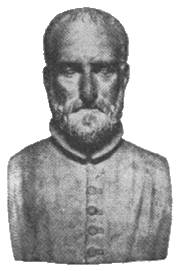Introduction
(born ?Palestrina, ?3 Feb. 1525 - 2 February 1526; died Rome, 2 February
1594).
He was a pupil of Mallapert and Firmin Lebel at St. Maria Maggiore,
Rome, where he was a choirboy from at least 1537. He became organist of
St. Agapito, Palestrina, in 1544 and in 1547 married Lucrezia Gori there;
they had three children. After the Bishop of Palestrina's election as pope
(Julius III) he was appointed maestro di cappella of the Cappella
Giulia in Rome (1551), where he issued his first works (masses, 1554);
during 1555 he also sang in the Cappella Sistina. Two of Rome's greatest
churches then procured him as maestro di cappella, St. John Lateran
(1555-60) and St. Maria Maggiore (1561-6), and in 1564 Cardinal Ippolito
d'Este engaged him to oversee the music at his Tivoli estate. From 1566
he also taught music at the Seminario Romano, before returning to the Cappella
Giulia as maestro in 1571.
During the 1560s and 1570s Palestrina's fame and influence rapidly increased
through the wide diffusion of his published works. So great was his reputation
that in 1577 he was asked to rewrite the church's main plainchant books,
following the Cuoncil of Trent's guidelines. His most famous mass, Missa
Papae Marcelli, may have been composed to satisty the council's requirements
for musical cogency and textual intelligibility. He was always in tune
with the Counter-Reformation spirit; after his wife's death in 1580 he
considered taking holy orders, but instead he remarried (1581). His wife,
Virginia Dormoli, was a wealthy fur merchant's widow; his investments in
her business eased his financial strains, and his last years at St. Peter's
were among his most productive.
Palestrina ranks with Lassus and Byrd as one of the greatest Renaissance
masters. A prolific composer of masses, motets and other sacred works,
as well as madrigals, he was (unlike Lassus) basically conservative. In
his sacred music he assimilated and refined his predecessors' polyphonic
techniques to produce a 'seamless' texture, with all voices perfectly balanced.
The nobility and restraint of his most expressive works established the
almost legendary reverence that has long surrounded his name and helped
set him up as the classic model of Renaissance polyphony.
Extracted with permission from
The Grove Concise Dictionary of Music
edited by Stanley Sadie
© Macmillan Press Ltd., London. |
Detailed Information about
-
Picture Gallery
-
List of Works
-
Bibliography
can be found on the internet on:
Classical Music Pages:  |
This project was created by Matt Boynick.
© 1 February 1996
Last Revision - 25 August 1999
|

